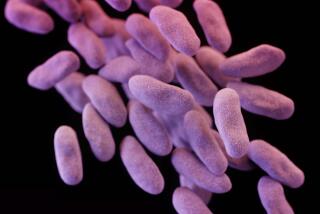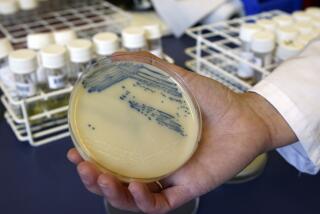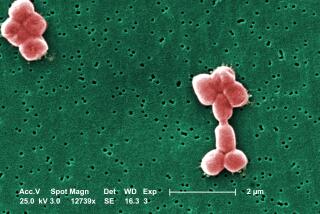In soil-dwelling bacteria, scientists find a new weapon to fight drug-resistant superbugs

Researchers examined 2,000 soils and found a new class of antibiotics.
It’s a new class of antibiotic that promises to live up to its rough Latin translation: killer of bad guys.
In a report published this week in the journal Nature Microbiology, researchers describe a never-before-seen antibiotic agent that vanquished several strains of multidrug-resistant bacteria. In rats, the agent — which the researchers dubbed malacidin — attacked and broke down the cell walls of methicillin-resistant Staphylococcus aureus and cleared the animals’ MRSA skin infections within a day.
Malacidin is short for metagenomic acidic lipopeptide antibiotic-cidins. (Also, “mal” means bad in Latin, and “cide” means to kill.) It is a distant relative of daptomycin, a powerful antibiotic that uses calcium to disrupt bacterial cell walls.
Malacidin appears to work differently than daptomycin, which was introduced in 2003 and has yet to be challenged by resistant bacteria. But scientists have reason to believe it will hold up at least as well. Even after 20 days of continued contact with malacidin — more than enough time for most bacteria to find a way to thwart an antibiotic’s effects — samples of MRSA bacteria showed no signs of evolving resistance to the newly discovered agent.
Not bad for a compound that’s been hiding in soil for eons.
Indeed, the method used by researchers to find and develop malacidin holds the promise of discovering many more potential medicines that live in soil but whose antibiotic properties elude researchers because they can’t be cultured in a lab.
The discovery of a new class of antibiotic medication would be a red-letter event: Researchers haven’t brought forth a truly new antimicrobial medication since 1987.
But an even more singular event would be the discovery of a new class of antibiotics that doesn’t prompt the development of resistant strains of bacteria.
Ever since the mid-1940s, after penicillin was discovered by microbiologist Alexander Fleming and rushed into development, the introduction of new antibiotics has quickly given rise to disease-causing bacteria capable of eluding their effects.
As a result, many of the workhorses of the world of antibiotics — members of the penicillin, cephalosporin and carbapenem classes — are losing their ability to fight a lengthening list of bacterial diseases.
The result has been called a “slow catastrophe”: the Centers for Disease Control and Prevention estimate that each year, at least 23,000 people now die as a direct result of bacterial infections that have become resistant to existing medicines. And many more die from other conditions that were complicated by an antibiotic-resistant infection.
Unless new antibacterial agents are discovered and turned into medicines, mortality rates due to untreatable infections are predicted to rise more than tenfold by 2050.
This is where malacidin becomes most interesting.
More remarkable than what it does is how scientists found it, and that process is described at some length in the new report. The result could be new discoveries, and a new way of sifting the soil for compounds that might make good medicine.
Chemical biologist Sean Brady and his colleagues at Rockefeller University in New York sequenced bacterial DNA extracted from 2,000 soil samples taken from across the United States.
Brady’s team was looking specifically for distant relatives of daptomycin, which uses calcium to bust up, break down and generally disrupt the cell walls of target bacteria. They knew that long after the effectiveness of other antibiotics has waned, daptomycin continued to kill its targets, and they surmised that its distinctive use of calcium might be the key to an antibiotic compound’s longevity.
They also knew that trying to culture all their soil samples in a lab would take forever, and that most would not replicate themselves under lab conditions anyway. So instead, they used high-speed computer processing to “screen” the soil samples for the distinctive chemical hallmark of calcium dependence.
When they found what they were looking for in a particular sample of desert soil, they captured and cloned the relevant genes, rearranged and inserted them into a host organism, and expanded the resulting sample through fermentation. This process made it possible to test the unique properties of malacidin on MRSA-infected rats.
“They’ve used a clever approach to mine for antibiotics,” said microbiologist Kim Lewis, who directs Northeastern University’s Antimicrobial Discovery Center and wasn’t involved in the work. By narrowing their search for the DNA signature of calcium dependence, they were able to find a needle in a haystack — and find a promising compound.
“Now we need to say, ‘You guys can do even better,’” Lewis said.
To demonstrate that their discovery is more than a one-time event, he said, Brady and his team need to identify and screen for additional DNA signatures that may predict potent antibiotic effects, “and go after them as well.”
MORE IN SCIENCE
Snooping around in hospital pipes, scientists find DNA that fuels the spread of superbugs
What do you see when you put miniature glasses on praying mantises? A new method for robot vision
Trifecta of opioids, alcohol and suicide are blamed for the drop in U.S. life expectancy







